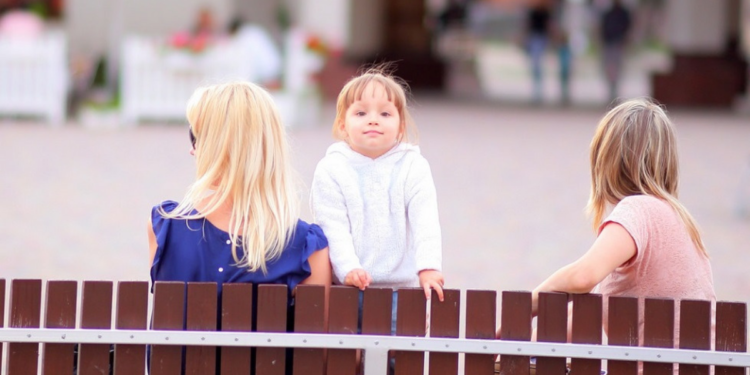We can look into the eyes of our children to see the impact of PCS moves. We can listen to the impact by the sound of a slammed door and the sobs deep in the recesses of their bedroom. We can feel the impact on them when we wrap our arms around them in a strong embrace and whisper, “I’m sorry.”
As parents, we know PCSing frequently from location to location has an impact on our children. We don’t need research to validate that tight feeling in our stomach or the blanket of worry that covers us when we learn the news of another PCS. We’ve become really good at hiding the fact that we see the impact – covering with smiles, excitement and promises of adventures.
Of course, we know that our kids will bounce back. They always do. We know adventure awaits them including new friends, a new school, and a new home. As adults, we know the good always outweighs the bad. We have the advantage of perspective. For a young tween, the newly minted six-year-old, or the high school junior, perspective is an elusive concept.
We may not need studies, academia or professionals to validate us, but it may help us understand the bigger picture versus the local and intimate influence moving has on our families.
With the recent refocus of resources aimed at understanding the needs of military families, there has been a plethora of reports and studies on the impact that moving (transition) has on military children. We sorted through a dozen studies and stats and spoke to professionals to recap the real “impact” moving has on our families at large.
Facts:
There are currently 2,000,000 military-connected children in America. Of those:
- 1,381,584 of the military-connected children are ages 4-18 years old.
- Over 80 percent of these children – 1,105,267 students – attend Pre-K through 12 public schools.
- Every school district in the country has military-connected students.
- Approximately 10 to 12 percent of military-connected students are served in special education programs.
- Military families move an average of every two to three years, that means approximately 500,000 military children change schools every year.
- Active (Duty) Kids
517,734 children in preschool (ages 0-5)
516,324 children in primary school (ages 6-14)
186,883 children in high school or older (ages 15-22)
Now that we’ve established the numbers, let’s take a look at the real impact moving has on our kids.
One change of duty station for a military child equals the following:
- A change of address
- A change of school
- A change of teachers
- A change of friends
- A change of worship
- A change of weather
- A change in scenery
- A change in schedules
- A change in routines
- A change in neighborhoods
- A change in activities
- A change in housing
Let that sink in for a minute. It’s a lot of change we ask our children to endure – every two to four years.
The Health Behavior News Service Journal of Adolescent Health, part of the Center for Advancing Health, found that children in military families who relocate have an increased odds of suffering mental health problems.
The study, which had more than 500,000 children with military parents, found that those who made a geographic move had increased odds of mental health problems when compared to kids who did not move. It also found that kids 12 to 17 who moved were more likely to require emergency mental health visits than kids 6 to 11. A unique finding was mental health issues in kids who moved included attention deficit, conduct disorders, self-injury and suicidal behaviors.
The study conclusion said geographic moves have been reported to have a negative impact on the mental health of children, but it is often difficult to separate the effect of the move from the circumstances that caused it. Since moves are common in military families, but parental employment and healthcare coverage remain constant, this study group offered a way to look more closely at the impact of a move on mental health status in children.
This increase in mental health problems was somewhat surprising, given previous research has suggested that children of military families do very well psychologically with geographic moves.
“This reinforces things that we have always known intuitively,” said R. Scott Benson, M.D., a child psychiatrist in private practice in Pensacola, Fla., and a former speaker of the American Psychiatric Association Assembly. “It showed that these children experience these moves as stressors.” Parents should consider the effects of a move on their children and give close consideration to their developmental needs, Benson said. Parents and teachers need to help children become acclimated after a move, he added.
We spoke with Amanda Trimillos, a military spouse, mom of four, and a teacher and a professional with National Board Certified Teacher (NBCT) about the impact moving has on school-aged children. Amanda is an advocate for military children and the Program Ambassador for NBCT. She’s hosted many webinars for educators and professionals hoping to mitigate the impact changing schools has on military children.
She says that moving has a two-fold impact on the children – academically and socially.
“Children usually fall into one of two categories when they arrive in a new school after a PCS. The first is that they are bored, twiddling their thumbs with the curriculum because they’ve already covered the material in their last school. Teachers normally don’t know what do with these students; sometimes making them class helpers until the material catches up the students. The other category is students who are behind the curriculum, lost with assignments, and are playing a major game of catch up before they feel they are part of the class. The crazy thing is one student can fit both profiles – they could be behind in math but ahead in reading. Either way, they have six weeks of adjustments ahead them, only to do it again year or two later.”
Amanda believes, and studies back up her assumptions, that if a student is not positively integrated academically at their new school, then they will also struggle socially as well. She says schools play a major role in setting new students up for success.
“Does the school offer orientation program for new students? Does the school offer buddy programs or do they have over all awareness of their new students? The success of your child may be directly linked to the support system and understanding your school has to offer new students. “
Amanda is first to point out that not all schools understand the uniqueness of military children. She says, “Although a school may claim they are ‘military friendly,’ when they are pushed to define what that means, it boils down to being not ‘anti-military.’”
The truth is that most of the impact our children feel when they move can be alleviated with help from the schools. A recent study conducted by University of Southern California Department of Social Work recommend military children become a distinct cultural group by schools in order to better serve them. The study also found that schools that have a supportive school climate toward military children have a much greater impact on children than just families and the military community alone.




